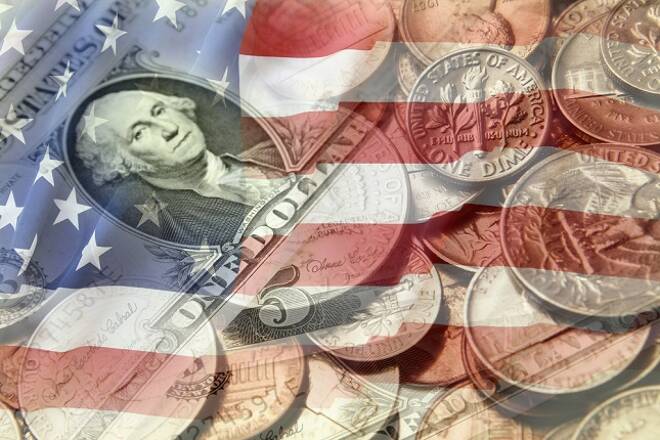Advertisement
Advertisement
Fed’s Outlook on Inflation One Factor Driving Rates Higher
By:
The 10-year U.S. Treasury yield jumped to a four-year high last week as investors bet on accelerating inflation from this growing economy.
A slew of U.S. economic data, a speech by President Donald Trump and the U.S. Federal Reserve’s monetary policy statement dictated the movement in Treasury yields and the U.S. Dollar last week. The rapid rise in Treasury yields in particular drove the price action in several sectors including commodities and financials with gold prices and stock prices falling sharply.
March U.S. Dollar Index futures settled the week at 89.036, up 0.145 or +0.16%.
The week started with Conference Board Consumer Confidence coming in better-than-expected at 125.4. This beat the 123.2 forecast. The previous month’s report was revised upward to 123.1.
In his first State of the Union speech on Tuesday night, President Donald Trump highlighted positive economic developments and touted initiatives such as the Republican tax-cut bill the president signed into law in December.
Trump also laid out his vision for reforming the nation’s infrastructure and ensuring what he considers “fair” trade with other nations.
Known for his harsh tone in speeches and periodic tweets, President Trump sought to deliver a softer, more optimistic address. The official theme of the speech was “a safe, strong and proud America.”
Trump spoke on various topics ranging from healthcare to immigration to infrastructure spending.
The U.S. Federal Reserve ended its two-day meeting on Wednesday by announcing it would not raise its benchmark interest rate. However, it indicated that it expects inflation pressures to heat up as the year moves on.
The decision by the Federal Open Market Committee to leave interest rates at 1.25 to 1.50 percent was widely expected. Additionally, according to projections released in December, FOMC officials expect three rate hikes this year so long as there is no significant disruption to market conditions. Recent price action in the Treasury markets, however, suggests that investors believe the Fed is considering a fourth rate hike.
On Thursday, a solid ISM Manufacturing PMI report showed the economy was getting stronger. It came in at 59.1, higher than the 58.7 estimate, but below the previous month’s 59.7 read.
The U.S. Labor Department reported Friday that the U.S. economy added 200,000 jobs in January, beating economist expectations of 180,000 jobs added. The unemployment rate came in as expected at 4.1%, unchanged from the previous month.
In addition to the robust headline news, yields were driven higher by strong evidence of rising wages. Average hourly earnings posted a 0.3 percent gain for the month and an annualized gain of 2.9 percent, the best gain since the early days of the recovery in 2009.
AUD/USD and NZD/USD
The Australian and New Zealand Dollars finished the week sharply lower against the U.S. Dollar. The price action suggests that investors finally believe the U.S. economy is just too strong and the U.S. Federal Reserve too aggressive for the Aussie and the Kiwi to continue to maintain their attractiveness as a high-yielding currencies.
The AUD/USD settled at .7919, down 0.0189 or -2.33% and the NZD/USD finished the week at .7299, down 0.0056 or 0.76%.
Australia’s inflation rate remained constrained in the December quarter diminishing hopes for a sooner-than-expected rate high by the Reserve Bank of New Zealand. Headline inflation edged up 0.6 percent over the quarter and 1.9 percent over the year, slightly below market expectations.
Underlying inflation, which strips out volatile items and is more closely watched by the Reserve Bank in setting interest rates, rose just 0.4 percent for the quarter.
Over the year, core inflation rose 1.9 percent to remain under the RBA’s target band of 2-3 percent.
According to London-based currency hedge fund manager Mark Farrington, “Eventually this very long expansion and bull market has to end with some kind of recession. Until that day comes all of the potential for a growth, and inflation, surprise and higher rates will come from the US.”
Farrington added, “Interest rates may have to stay lower for longer in Australia than you would otherwise think in an economy with high exposure to housing and high household leverage.”
USD/JPY
Rising U.S. Treasury yields, helped by a somewhat hawkish Fed monetary policy statement and strong U.S. economic data helped drive the Dollar/Yen higher last week. The Japanese Yen was also under pressure after the Bank of Japan increased its buying of medium-term Japanese Government Bonds in a move seen as a warning shot against further rises in bond yields.
The USD/JPY settled at 110.137, up 1.523 or +1.40%.
The 10-year U.S. Treasury yield jumped to a four-year high last week as investors bet on accelerating inflation from this growing economy. The 10-year note was up roughly 4 basis points at 2.837 percent, while the yield on the 30-year Treasury bonds was up roughly 5 basis points at 3.08 percent.
About the Author
James Hyerczykauthor
James Hyerczyk is a U.S. based seasoned technical analyst and educator with over 40 years of experience in market analysis and trading, specializing in chart patterns and price movement. He is the author of two books on technical analysis and has a background in both futures and stock markets.
Advertisement
